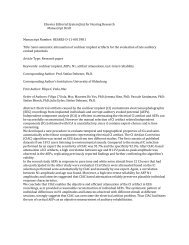Output frequency response function-based analysis for nonlinear ...
Output frequency response function-based analysis for nonlinear ...
Output frequency response function-based analysis for nonlinear ...
Create successful ePaper yourself
Turn your PDF publications into a flip-book with our unique Google optimized e-Paper software.
118<br />
fundamental results, techniques, and a general procedure <strong>for</strong> the determination of the OFRF <strong>for</strong> a given NDE<br />
or NARX model subject to any specific input signal are provided. Although the proposed method needs r(N)<br />
simulation data <strong>for</strong> the numerical method of Process C, and the OFRF obtained by the proposed method is<br />
not analytical with respect to the input signal and <strong>frequency</strong> variants at present, the case study <strong>for</strong> a simple<br />
mechanical system shows that the OFRF-<strong>based</strong> <strong>analysis</strong> is a useful approach to the <strong>analysis</strong> and design of<br />
<strong>nonlinear</strong> Volterra systems in the <strong>frequency</strong> domain.<br />
Acknowledgements<br />
The authors take their gratitude to the anonymous reviewers <strong>for</strong> their useful and constructive comments<br />
and suggestions on the manuscript, and also gratefully acknowledge the support of the EPSRC-Hutchison<br />
Whampoa Dorothy Hodgkin Postgraduate Award, <strong>for</strong> this work.<br />
Appendix A. Proof of Proposition 1<br />
CEðHnðjo1; ...; jonÞÞ<br />
¼ C0;n<br />
n<br />
p¼2<br />
n 1 n q<br />
q¼1 p¼1<br />
0<br />
B<br />
@<br />
Cp;0<br />
0<br />
B<br />
@<br />
Cp;q<br />
0<br />
B<br />
@<br />
n pþ1<br />
0<br />
B<br />
@<br />
p<br />
r1 rp¼1 P i¼1<br />
ri ¼n<br />
n q pþ1<br />
p<br />
r1 rp¼1 P i¼1<br />
ri ¼n q<br />
CE Hri ðjorXþ1 ; ...; jorXþr i Þ<br />
CE H ri ðjorXþ1 ; ...; jorXþr i Þ<br />
11<br />
CC<br />
AA<br />
11<br />
CC<br />
AA.<br />
ðC1Þ<br />
C0,n is the first term in Eq. (C1). For clarity, consider a simpler case that there is only output <strong>nonlinear</strong>ities in<br />
Eq. (C1), then Eq. (C1) is reduced to only the last term of Eq. (C1), i.e.,<br />
n<br />
CEðHn;pð ÞÞ ¼ p¼2<br />
n<br />
Cp;0<br />
n pþ1<br />
p<br />
r1 rp¼1 P i¼1<br />
ri ¼n<br />
[24] in order to finish the proof. &<br />
Appendix B. Proof of Proposition 2<br />
Cp;0<br />
p¼2<br />
CEðHri ð ÞÞ. At this stage, the reader is recommended to refer to Jing et al.<br />
Regard all other <strong>nonlinear</strong> parameters as constants or 1. From Proposition 1, if p+q4n then the parameter<br />
has no contribution to CE(Hn(.)), in this case CE(Hn(.)) ¼ 1 with respect to this parameter. Similarly, if<br />
p+q ¼ n then the parameter is an independent contribution in CE(Hn(.)), thus CE(Hn(.)) ¼ [1c] with respect to<br />
this parameter in this case. If p+qon and p40, then the independent contribution in CE(Hn(.)) <strong>for</strong> this<br />
ðn1Þ= ðpþq1Þ parameter should be cb c , and the monomials c x <strong>for</strong> 0pxo n 1=p þ q 1 are all not<br />
independent contributions in CE(Hn(.)). Hence CEðHnð ÞÞ ¼ 1; c; c2 h i<br />
ðn1Þ= ðpþq1Þ ; ...; cb c <strong>for</strong> this case. The<br />
similar result is held <strong>for</strong> the case p+qon and p ¼ 0. However, since there should be at least one p40 ina<br />
complete monomial, thus in this latter case c x<br />
<strong>for</strong> any x are not complete, which follows<br />
CEðHnð ÞÞ ¼ 1; c; c2 h i<br />
ðn1Þ= ðpþq1Þ ; ...; cb c 1 . The parametric characteristic vector <strong>for</strong> the <strong>nonlinear</strong><br />
parameter c <strong>for</strong> all the cases above can be summarized into<br />
CEðHnð ÞÞ ¼ 1; c; c 2 ; ...; c<br />
This completes the proof. &<br />
ARTICLE IN PRESS<br />
X.J. Jing et al. / Mechanical Systems and Signal Processing 22 (2008) 102–120<br />
n 1<br />
n 1<br />
pþq 1 dðpÞ posðn qÞ d pþq 1<br />
n 1<br />
pþq 1 .

















